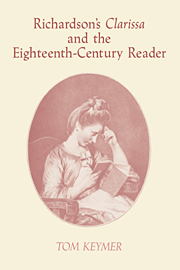Book contents
4 - Forensic realism The third instalment, December 1748
Published online by Cambridge University Press: 24 October 2009
Summary
I think ye Author a Person of refind understanding, but that he has Needlessly spun out his Book to an extravagant Prolixity – & which he would scarce have done, had he not been a Printer too as well as an Author. Nothing but Fact could authorize so much particularity, and indeed not that; but in a Court of Justice –
Shenstone to Lady Luxborough, 23 March 1749/50, on reading ClarissaProvidence, anti-Providence and the instability of justice
In the late seventeenth century and for much of the eighteenth, Shakespeare's King Lear was supplanted by Nahum Tate's notorious revision of the play, which brought it into conformity with contemporary desires and expectations by ‘making the Tale conclude in a Success to the innocent distrest Persons’. The apocalyptic original was barely tolerable to the audiences of Richardson's day, who (as one of Tate's modern editors notes) were ‘more interested in thickening the walls than in being shown the nearness of chaos’. Edward Moore felt ‘no other Passion than Terror’ at the play, Joseph Warton found it ‘painted with circumstances too savage and unnatural’, and John Dennis complained that the deaths of Cordelia and Lear ‘call the Government of Providence into Question’: all three typify the climate of taste and opinion in which Tate's more consoling version could hold the stage. Even Johnson, who saw in the original a demonstration ‘that villany is never at a stop, that crimes lead to crimes, and at last terminate in ruin’, was unprepared to see the demonstration pursued to its catastrophe in Shakespeare's fifth act, which he found ‘contrary to the natural ideas of justice, [and] to the hope of the reader’.
- Type
- Chapter
- Information
- Richardson's 'Clarissa' and the Eighteenth-Century Reader , pp. 199 - 244Publisher: Cambridge University PressPrint publication year: 1992



